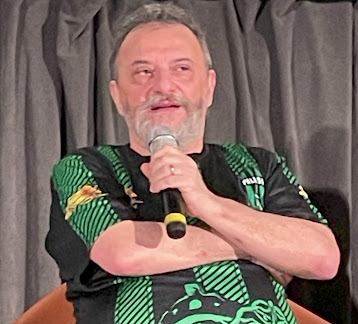Everybody knows Italy loves football (or "soccer"). But, when co-director Marco Manetti - before the film begins in Milan's Anteo-Palazzo del Cinema - asks the audience "Is there anyone who doesn't love football, here?" I have to raise my hand. Yes, well, I don't care much for football, although once in a while I watch games of the Italian or Spanish national football teams. But that doesn't mean I cannot enjoy a story about football: after all I don't need to know about fishing to read The Old Man and the Sea or to be a martial artist to enjoy Enter the Dragon.
The new film by acclaimed Italian directors Manetti bros - Marco e Antonio Manetti - is about a big football star who ends up in a small amateur football team, a fallen hero who gets back on his track at last. And about the town of Palmi, in the province of Reggio Calabria, with the kind of people you might find in any southern Italian... or actually any Italian town; and about their dreams. It's social Italian comedy at its best, a sports movie and, undoubtedly, a Manetti movie, with their own brand of irony and empathy.
But, of course, I might be biased, because I've known the two guys for quite some time, I love them and their films. I've been working with them - mostly Marco - on the novelizations of their Diabolik film trilogy and now I realize why he sometimes answered my calls from Paris... But, mostly, I always enjoy their way of making movies.
In Milan, young football French star Etienne Morville (played by former Belgian football player turned actor Blaise Afonso) grown up in the banlieues of Paris, has become rich, spoiled, aggressive; although he invented a unique move called "Houdini", he now makes the news mostly because of his unpleasant behaviour.
Meanwhile in Palmi Vincenzo (Rocco Papaleo), a pensioner and widower who lives with his daughter Concetta (Giulia Maenza), sitting in a café talking football with his friends, makes a few calculations: if every citizen of Palmi gave 300 euros, the local amateur football team - Unione Sportiva Palmese, or U. S. Palmese - might be able to buy a real champion, such as Morville.
Concetta is doubtful. Palmi's poetess Ferraro (Claudia Gerini) thinks football is the opium of the peoples. Anyway, not only Vincenzo manages to collect the money, but Morville's manager forces the football star to accept the offer, in order to clean up his name and image. After the big teams and the big life in Paris or Milan, now the place and the game are totally different. At first, Morville doesn't seem to accept the new rules. Till he finds himself again, changing his life, the team and the town, with a few surprising twists at the ending.
Meanwhile, in the real world, Palmese has become one of the most famous football teams in Italy. U.S. Palmese was filmed in Paris, Milan and of course the directors' beloved Palmi, birthplace of their mother (to whom the film is dedicated). Spoken in Italian, French and the local dialect, the movie makes use of several technical tricks, some of which - says Marco - inspired by the Japanese anime series Captain Tsubasa. Manetti fans can recognize their style in shooting, but also their enduring love for cinema.
Besides, in their path through different film genres (horror, sci-fi, crime, musical and now sports) they also seem to have now found the epic, the faces and even the film score (as usual by Pivio & Aldo De Scalzi, here dotted by rap from the three different movie locations) that could allow them to make their own spaghetti western.
I just had time to ask them about it, while they were surrounded by fans in the theatre's foyer. "Who knows..." said Marco.














